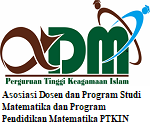Modeling of COVID-19 Epidemic Growth Curve in Indonesia
DOI:
https://doi.org/10.15642/mantik.2021.7.1.67-73Keywords:
Modeling, Logistic, Gompertz, Epidemic, COVID-19Abstract
Aim of this study is to make parametric modeling of the COVID-19 epidemic growth curve so that the maximum value and time at that point can be obtained from the cumulative cases of COVID-19. The data used in this study is the cumulative number of positive confirmed cases of COVID-19 from https://covid19.go.id/. The method used in this study is fitting data with the Logistic and Gompertz models. Result of this study are (1) the Logistic and Gompertz models are very fit in modeling the COVID-19 epidemic growth curve, indicated from the value of R2 (coefficient of determination) which reaches more than 99%; (2) From the Logistics model it is obtained that the estimated amount of the maximum cumulative case at the end of the COVID-19 epidemic is 7,714 positive confirmed cases, achieved in about 82 days (May 22, 2020) from Mar 2, 2020, when the first positive COVID-19 case was announced by the government; and (3) From the Gompertz model, it is obtained that the estimated maximum cumulative case at the end of the COVID-19 epidemic is 33,975 positive confirmed cases, achieved in about 152 days (Jul 30, 2020) from Mar 2, 2020. The results of this study can be used as input to the government to take steps in controlling the spread of COVID-19.
Downloads
References
Ahmadi A, Fadai Y, Shirani M, Rahmani F. Modeling and forecasting trend of COVID-19 epidemic in Iran. 2020. DOI: https://doi.org/10.1101/2020.03.17.20037671.
Arino J, Brauer F, Van Den Driessche P, Watmough J, Wu J. A final size relation for epidemic models. Math Biosci Eng. 2007;4:159. DOI: 10.3934/mbe.2007.4.159.
Bates D M, Watts D G. Nonlinear Regression Analysis and Its Applications, Wiley. 1988. DOI: 10.1002/9780470316757.
Datolli G, Di Palma E, Licciardi S, Sabia E. A note on the Evolution of Covid-19 in Italy. 2020. https://arxiv.org/pdf/2003.08684.pdf.
Gorbalenya A E, Baker S C, Baric R S, de Groot R J, Drosten C, et al. 2020. Severe acute respiratory syndrome-related coronavirus: The species and its viruses - a statement of the Coronavirus Study Group. biorXiv. 2020. DOI: https://doi.org/10.1101/2020.02.07.937862.
Gao D, Lou Y, He D, Porco TC, Kuang Y, Chowell G, et al. Prevention and control of Zika as a mosquito-borne and sexually transmitted disease: a mathematical modeling analysis. Sci Rep. 2016;6:28070. DOI: 10.1038/srep28070.
He D, Gao D, Lou Y, Zhao S, Ruan S. A comparison study of Zika virus outbreaks in French Polynesia, Colombia and the State of Bahia in Brazil. Sci Rep. 2017;7:273. DOI: 10.1038/s41598-017-00253-1.
Jones J. H. 2007. Notes on R0. https://web.stanford.edu/~jhj1/teachingdocs/Jones-on-R0.pdf.
Jia L, Li K,Jiang Y, Guo X, Zhao T. Prediction and analysis of Coronavirus Disease 2019. 2020. https://arxiv.org/ftp/arxiv/papers/2003/2003.05447.pdf.
Ma J, Earn DJ. The generality of the final size formula for an epidemic of a newly invading infectious disease. Bull Math Biol. 2006;68:679–702. DOI: 10.1007/s11538-005-9047-7.
Razzak, W.A. Modelling New Zealand COVID-19 infection rate, and the efficacy of social distancing policy. Economics discussion paper 20.04. 2020. http://econfin.massey.ac.nz/school/publicati-ons/discuss/2020/DP2004.pdf.
Tjørve KMC, Tjørve E. The use of Gompertz models in growth analyses, and new Gompertz-model approach: An addition to the Unified-Richards family.PLoS ONE.2017; 12(6): e0178691. https://doi.org/10.1371/jou-rnal.pone.0178691.
www.covid19.go.id. Diakses 12 April 2020 pukul 18:00 WIB.
Zhang Q, Sun K, Chinazzi M, Pastore y Piontti A, Dean NE, Rojas DP, et al. Spread of Zika virus in the Americas. Proc Natl Acad Sci USA. 2017;114:E4334–43. DOI: 10.1073/pnas.1620161114.
Zhao S, Chen H. Modeling the epidemic dynamics and control of COVID-19 outbreak in China. Quant Bio. 2020, 8(1): 11–19. DOI: https://doi.org/10.1007/s40484-020-0199-0.
Zhao S, Stone L, Gao D, He D. Modelling the large-scale yellow fever outbreak in Luanda, Angola, and the impact of vaccination. PLoS Negl Trop Dis. 2018;12:e0006158. DOI: 10.1371/journal.pntd.0006158.
Zwietering M, Jongenburger I, Rombouts F, van ’T Riet K. 1990). Modeling of the Bacterial Growth Curve. Appl & Env Micr. 1990; 56:1875. DOI: 10.1128/AEM.56.6.1875-1881.1990.
Downloads
Published
How to Cite
Issue
Section
License
- Authors retain copyright and grant the journal right of first publication with the work simultaneously licensed under a Creative Commons License that allows others to share the work with an acknowledgment of the work's authorship and initial publication in this journal.
- Authors are able to enter into separate, additional contractual arrangements for the non-exclusive distribution of the journal's published version of the work (e.g., post it to an institutional repository or publish it in a book), with an acknowledgment of its initial publication in this journal.
- Authors are permitted and encouraged to post their work online (e.g., in institutional repositories or on their website) prior to and during the submission process, as it can lead to productive exchanges, as well as earlier and greater citation of published work







.png)




